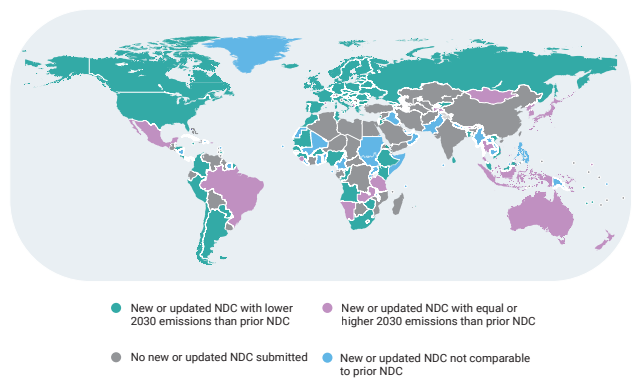Biodiversity & Environment
Emissions Gap Report 2021: UNEP
- 30 Oct 2021
- 5 min read
Why in News
Recently, the United Nations Environment Programme (UNEP)’s Emissions Gap Report 2021 has been published.
- This is the twelfth edition of the UNEP Emissions Gap Report. It informs that the new national climate pledges combined with other mitigation measures put the world on track for a global temperature rise of 2.7°C by the end of the century.
Key Points
- GHGs Continue to Rise:
- Following an unprecedented drop of 5.4 % in 2020, global carbon dioxide emissions are bouncing back to pre-COVID levels, and concentrations of GreenHouse Gases (GHGs) in the atmosphere continue to rise.
- New Mitigation Pledges:
- New mitigation pledges for 2030 show some progress, but their aggregate effect on global emissions is insufficient.
- As a group, G20 members are not on track to achieve either their original or new 2030 pledges.
- Ten G20 members are on track to achieve their previous Nationally Determined Contributions (NDC), while seven are off track.
- Compared to previous unconditional NDCs, the new pledges for 2030 reduce projected 2030 emissions by only 7.5 %, whereas 30 % is needed for 2°C and 55 % is needed for 1.5°C.
- Net-zero Emissions:
- The long-term net-zero emissions pledged by 50 countries, covering more than half of global emissions show large ambiguities.
- Net zero emission means that all man-made greenhouse gas emissions must be removed from the atmosphere through reduction measures, thus reducing the Earth's net climate balance, after removal via natural and artificial sink.
- Few of the G20 members' NDC targets put emissions on a clear path towards net-zero pledges.
- There is an urgent need to back these pledges up with near-term targets and actions that give confidence that net-zero emissions can ultimately be achieved and the remaining carbon budget kept.
- The long-term net-zero emissions pledged by 50 countries, covering more than half of global emissions show large ambiguities.
- Global Warming:
- At the end of the century global warming is estimated at 2.7°C if all unconditional 2030 pledges are fully implemented and 2.6°C if all conditional pledges are also implemented.
- If the net-zero emissions pledges are additionally fully implemented, this estimate is lowered to around 2.2°C.
- Methane Emission:
- Reduction of methane emissions from the fossil fuel, waste and agriculture sectors can contribute significantly to closing the emissions gap and reduce warming in the short term.
- Carbon Markets:
- Carbon market can deliver real emissions abatement and drive ambition, but only when rules are clearly defined, designed to ensure that transactions reflect actual reductions in emissions, and supported by arrangements to track progress and provide transparency.
- Current Situation:
- The current atmospheric carbon dioxide (CO2) concentrations are higher than at any time in the last two million years.
- At present, there are no estimates available of total global GHG emissions for 2020.
- However, the COVID-19 pandemic led to an unprecedented 5.4 % drop in CO2 emissions in 2020, with a smaller drop in total GHG emissions expected for the year.
- From 2010 to 2019, GHG emissions grew by 1.3 % per year on average, both with and without land-use change (LUC).
- GHG emissions reached a record high of 51.5 gigatons of CO2 equivalent (GtCO2e) in 2019 without LUC emissions and 58.1 GtCO2e when including LUC.
- Initiatives to Reduce Emissions in India:
- Shift from Bharat Stage-IV (BS-IV) to Bharat Stage-VI (BS-VI) emission norms.
- Distribution of LED bulbs under the UJALA scheme.
- Formation of International Solar Alliance.
- Launch of the National Action Plan on Climate Change (NAPCC).
- Roadmap for Ethanol Blending in India by 2025.
United Nations Environment Programme (UNEP)
- About:
- It is a leading global environmental authority established on 5th June 1972.
- It sets the global environmental agenda, promotes sustainable development within the United Nations system, and serves as an authoritative advocate for global environment protection.
- Headquarters:
- Nairobi, Kenya.
- Major Reports:
- Emission Gap Report, Adaptation Gap Report, Global Environment Outlook, Frontiers, Invest into Healthy Planet.
- Major Campaigns:
- Beat Pollution, UN75, World Environment Day, Wild for Life.
Emissions Gap Report
- It assesses the gap between anticipated emissions in 2030 and levels consistent with the 1.5°C and 2°C targets of the Paris Agreement. Every year, the report features ways to bridge the gap.







